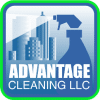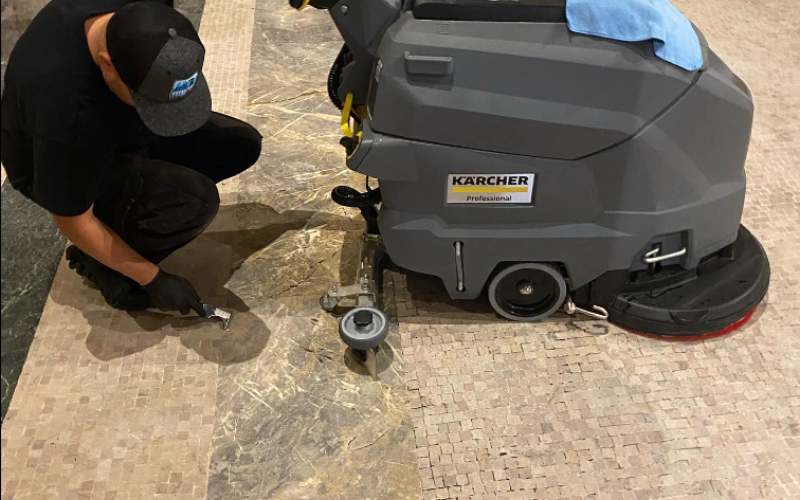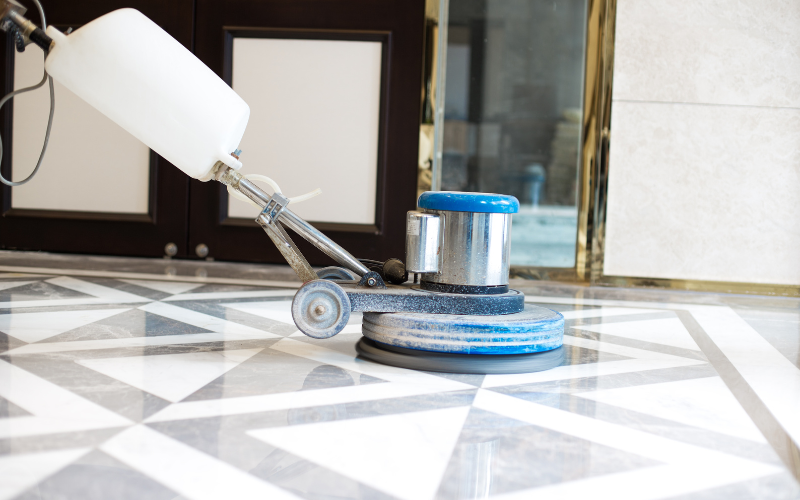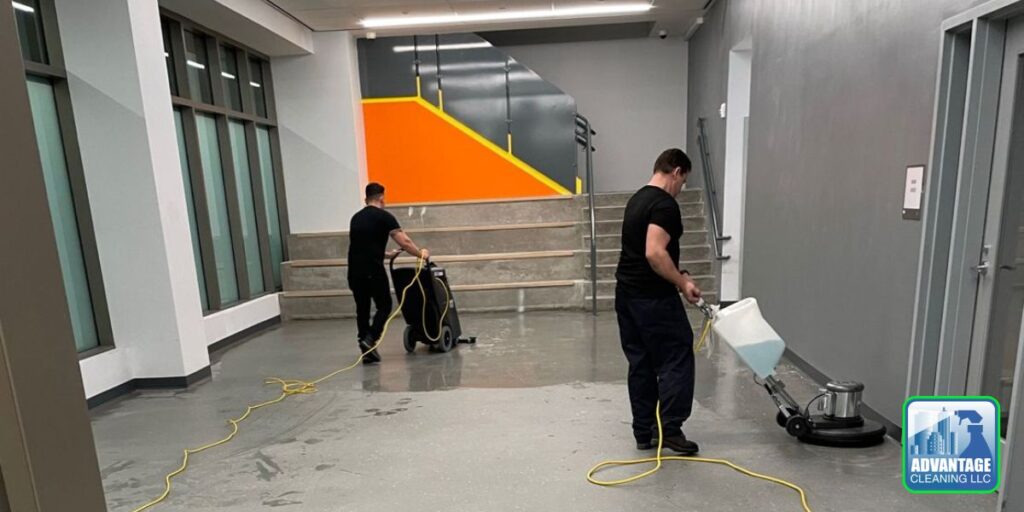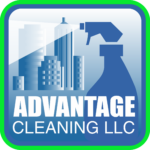This article focus on professional marble floor cleaning protocols for commercial properties. pH-neutral marble floor cleaning methods, stain removal, and systematic maintenance of marble floors in e.g. Class A commercial and residential buildings in New York, New Jersey, and Connecticut.
This guide shows facility directors and cleaning professionals how to maintain commercial marble floors without causing damage.
Key Message: Protecting Your Marble Floor Investment
Commercial marble floors represent significant property value and aesthetic appeal. Unlike standard flooring, marble requires specialized knowledge and systematic protocols.
Key takeaways:
- Only use pH-neutral cleaners specifically formulated for natural stone
- Respond to spills immediately (within 5 minutes for acids)
- Dry dust daily with soft microfiber to prevent scratches
- Seal regularly (every 6-12 months, test monthly)
- Train all staff to prevent accidental damage
- Call professionals for restoration needs
- Use the right tools for cleaning and maintaining marble floors to preserve shine and durability
Marble flooring can last a lifetime with regular maintenance and proper upkeep.
The difference between pristine marble floors and damaged ones comes down to understanding the stone’s chemistry and implementing systematic care protocols. For Class A properties, this knowledge protects both asset value and brand image.
Why Marble Floors Need Different Care
Marble flooring in commercial properties—from Manhattan office towers to luxury hotels—requires completely different maintenance than vinyl, ceramic, or even granite floors. Use the wrong cleaner, and you can permanently damage marble in seconds.
Marble consists primarily of calcium carbonate, making it highly susceptible to chemical reactions with acids. A cleaning solution that works perfectly on ceramic tile can permanently etch marble, destroying its finish.
Where marble floors are most common:
- Class A Office Buildings: One Vanderbilt, Hudson Yards—lobbies and executive floors
- Luxury Hotels: The St. Regis, The Plaza—entrances and public spaces
- Mixed-Use Developments: Brookfield Place, Time Warner Center—high-traffic retail areas
- Luxury Residential: 432 Park Avenue, 99 Hudson—common areas and amenities
To protect marble floors from scratches and surface damage, it is essential to regularly remove debris such as sand and loose dirt. These particles are abrasive and can easily scratch the soft marble surface if not swept or mopped away promptly. Regular dry dusting and immediate cleaning of any tracked-in sand or dirt help maintain the shine and integrity of marble flooring.
Marble ranks at 4 on the Mohs hardness scale, relatively soft compared to other commercial flooring. As a metamorphic natural stone, marble is highly sensitive with a soft surface that’ is easily scratched.
Understanding How Marble Is Different
The Chemistry Challenge of Marble Floors
When acidic products contact marble, the acid dissolves the calcite within the marble, causing a dull area called acid etching. Acid etching is damage to the stone’s composition and must be mechanically re-polished to fix—you can’t clean it away.
The pH scale:
The pH scale measures how acidic or basic a substance is, ranging from 0 to 14, with 7 being neutral; substances below 7 are acidic and above 7 are basic (Surprising substances that can etch marble).
Before using any new cleaning product on marble, always test it on an inconspicuous area first to ensure it does not cause damage or discoloration.
For marble floors:
- Safe: pH 7 (neutral only)
- Damage: pH below 7 (acidic) OR above 11 (strongly alkaline)
- Most cleaners: pH 2-6 or pH 9-12 (will damage marble)
The Porosity Challenge
Marble is moderately porous with a softer and more absorbent surface than granite, making it susceptible to staining and therefore requires more frequent re-sealing.
This means:
- Liquids penetrate quickly, causing deep stains—common culprits include fruit juice, which can leave organic stains on marble
- Spills need immediate response (minutes, not hours)
- High-traffic areas need more frequent sealing
- Even sealed marble can stain if spills aren’t cleaned fast
Key Differences Between Marble floors vs. Other Natural Stone Floors
| Aspect | Marble Floors | Ceramic/Vinyl Floors |
|---|---|---|
| pH tolerance | pH 7 only (neutral) | pH 1-14 (most cleaners work) |
| Cleaning products | Specialized stone cleaners only | General-purpose cleaners fine |
| Equipment | Soft microfiber only | Scrub brushes, aggressive pads OK |
| Etching risk | High – acids damage in seconds | No etching risk |
| Scratch resistance | Low – soft surface | High – durable surface |
| Spill response time | Immediate (under 5 minutes) | Can wait hours |
| Sealing frequency | Every 6-12 months | Once or never |
| Restoration needs | Professional honing/polishing | Simple refinishing |
| Vacuum restrictions | Plastic or metal vacuum attachments can cause etch marks in marble surfaces. | No restrictions |
Keeping marble floors clean requires specialized products and gentle techniques, unlike other flooring types that can tolerate general-purpose cleaners and more aggressive equipment.
Daily Floor Maintenance: What’s Different for Marble
Morning Dry Dusting
Dry mop daily to keep dirt and grit off the floor, which prevents scratches and keeps marble shiny.
Critical difference from other floors:
Use a dry microfiber mop and avoid scratchy, stiff brooms; soft mops are best. In high-traffic areas, dry-dust may be needed multiple times daily to prevent minute scratches that dull marble’s sensitive surface.
Why this matters: Grit particles act like sandpaper under foot traffic. What works fine on ceramic will scratch marble.
Frequency:
- High traffic (lobbies): 2-3 times daily
- Medium traffic (hallways): Once daily
- Low traffic (back areas): Every other day
Damp Mopping Technique
To prepare your cleaning solution, fill a bucket with warm water and add a few drops of mild dish soap, creating a very dilute solution. This gentle mixture is safe for marble floors and helps prevent residue or streaks. Use a second bucket filled with plain water for rinsing.
Dip a microfiber mop in the cleaning solution, wring out excess water, and gently mop the floor using the figure-eight technique.
Key difference: Use a damp (not wet) microfiber mop; excess water can seep into marble and cause damage.
After mopping: Rinse the floor with clean water from the second bucket to remove any remaining cleaner and dry thoroughly with a soft cloth to prevent water spots.
Immediate Spill Response
Soak up spills as soon as they occur, especially dark liquids like coffee and wine.
Blot spills immediately to prevent staining and etching; avoid wiping as it can spread the spill.
High-priority spills (respond in under 5 minutes):
Acidic substances such as lemon juice, vinegar, wine, coffee, and tomato sauce can penetrate porous marble and cause etching along with staining.
Priority list:
- Coffee and tea
- Wine (red or white)
- Citrus juices and soft drinks
- Tomato-based products and tomato sauce
- Any cleaning products (if spilled)
The pH-Neutral Cleaning Solution Requirement
Why Only pH-Neutral Products Work
Marble is very sensitive to chemicals and only pH neutral cleaners should be used on polished surfaces.
Always, avoid cleaners that contains acidic substances such as vinegar or lemon juice as they etch the marble surface.
Common Cleaners That Damage Marble Floors
When cleaning marble floor, NEVER use:
- Regular toilet bowl cleaners are very acidic, with a pH level of about 1 to 3 (Surprising Substances That Can Acid Etch Marble)
- Glass cleaners (often contain ammonia or acids)
- Bathroom cleaners for soap scum
- Tile and grout cleaners
- “All-purpose” cleaners (usually too alkaline)
- Vinegar, lemon juice, or other acidic cleaners.
This includes “natural” cleaning solution:
- Vinegar-based solutions
- Lemon-scented products
- Many “eco-friendly” cleaners with citric acid
Acidic substances like lemon juice don’t just stain—they dissolve the marble’s polished layer, creating permanent dull spots if not cleaned within minutes.
What cleaning solution to use instead
Use cleaners formulated specifically for natural stone that are neutral pH, gentle enough to use every day. A properly diluted pH-neutral cleaning solution is effective at removing grime from marble floors without causing damage.
Requirements:
- pH 7.0 or within 6.5-7.5 range
- Labeled “for marble” or “for natural stone”
- Leaves no residue
- Commercial concentration for high-volume use
Dilution for daily cleaning:
- Light soil: 1-2 oz. per gallon of water
- Normal cleaning: 2-4 oz. per gallon
- Heavy soil: Up to 6 oz. per gallon (maximum)
Never use more than recommended—stronger doesn’t mean better and can leave residue.
Preventing Mix-Ups in Commercial Settings
Using a non-pH neutral cleaning chemical on marble floor will damage the floor instantly. After a few seconds the chemical will have etched the marble and spots will appear immediately. The fix requires diamond abrasive machinery and hours of work before the marble surface is restored.
How to avoid using wrong cleaning products:
- Separate storage for marble-safe products
- Color-coded bottles and equipment
- Use blue equipment only for marble
- Train all staff, not just cleaning crews
- Clear labels in multiple languages
Marble Floor Deep Cleaning and Stain Removal
How often do marble floors need deep cleaning?
Deep clean marble floors at least once a month; in high-traffic areas, schedule deep cleaning more often.
Commercial schedule:
- Lobbies and entrances: Monthly
- Office areas: Quarterly
- Low-traffic areas: Semi-annually
Marble floor deep cleaning process
Step 1: Preparation
- Remove furniture
- Dry dust thoroughly
- Photo-document condition
Step 2: Cleaning
Use a pH-neutral cleaner to reduce streaks; wet the stone’s surface with water using a spray bottle or wrung-out mop to prevent soaking the floor.
- Work in 500-1000 sq ft sections
- Allow dwell time per product specs
- Use low-speed machine with white pad if needed
Step 3: Rinsing
Essential Care and Maintenance Tips for Marble Surfaces: rinse with clean water, replacing the water as often as needed, so that the cleaning water remains clean to avoid stains.
- Use wet vacuum to extract water
- Multiple rinse passes
- Water should run clear
Step 4: Drying
After deep cleaning, dry the surface with soft cloth; marble inlays often contain iron oxide, so leaving moisture can cause rust.
- Use air movers for large areas
- Microfiber cloths for detailed work
- Complete drying before replacing furniture
Stain Identification and Treatment
Different marble floor stains need different treatments.
Oily stains, such as those from cooking oils or cosmetics, can penetrate marble surfaces and require special treatment to remove them effectively.
1. Organic Stains (coffee, wine, food)
Organic stains are caused by natural materials including food like berries and tomatoes, and beverages like coffee, tea, and wine.
Appearance: Pinkish-brown to dark brown
Treatment: Poultice with powdered poultice materials and 12% hydrogen peroxide solution or use acetone.
2. Oil-Based Stains (grease, cosmetics)
Oil-based stains from cooking oils, grease, butter, and cosmetics might not be immediately visible but can darken marble over time.
Appearance: Dark spots that darken the stone
Treatment: An oil-based stain darkens the stone and must be chemically dissolved so the source can be flushed away (How to remove stains from stone applications). Poultice with baking soda and water or powdered materials and mineral spirits.
3. Rust Stains (metal objects, internal iron)
Marble contains the mineral iron sulfide (pyrite) that can develop orange-like rust stains naturally.
Marble itself can contain traces of ferrous minerals that, over time with moisture exposure, oxidize and form rust spots.
Appearance: Orange to brown discoloration
Treatment: Poultice with diatomaceous earth and commercially available rust remover; rust stains are particularly difficult and may require professional help.
4. Water Marks
Mineral deposits from hard water leave white, chalky stains.
Treatment: Buff with dry 0000 steel wool for surface deposits.
How to Apply a Poultice
A poultice draws stains out of porous marble.
The cleaning solutions you need:
- Absorbent powder (diatomaceous earth, kaolin, or baking soda)
- Appropriate liquid (water, hydrogen peroxide, acetone, or specialized remover)
- Plastic wrap
- Tape
Cleaning process:
- Clean area with pH-neutral cleaner
- Mix powder and liquid to peanut butter consistency
- Spread ¼ to ½ inch thick over stain
- Extend 1 inch beyond stain edges
- Cover with plastic wrap and tape edges
- Leave 24-48 hours
- Remove plastic and let poultice dry completely
- Scrape off with plastic scraper
- Rinse thoroughly and dry
For stubborn stains:
- May need 2-4 applications
- If no improvement after 3 tries, call professionals
When Cleaning Isn’t Enough: Understanding Restoration
Regular cleaning maintains marble floors, but it cannot fix physical damage. Etch marks are physical damage, not stains —they cannot be cleaned away with any product but requires professional marble floor restoration.
If marble floors show significant wear or when stubborn stains or etch marks cover a large area, it’s time to call in a professional. Signs include widespread dullness, fine scratches from constant foot traffic that rob the stone of its natural reflective shine, multiple etch marks across large areas, or deep stains that don’t respond to repeated poultice treatments.
The key difference between marble floor cleaning and restoration
Cleaning removes dirt, grime, and some stains using chemicals and poultices. Restoration physically removes damaged marble using diamond abrasives, then re-polishes the surface. Professional marble restoration addresses etched surfaces, cracked stone, and faded marble floors using proven techniques with specialized tools.
Marble floor restoration – for detailed information on the marble floor restoration process, diamond abrasive techniques, equipment requirements, and when to choose restoration over replacement, see our comprehensive guide: Marble floor restoration: complete professional guide.
When to Call Marble Floor Cleaning Professionals
If marble floors show significant wear or when stubborn stains or etch marks cover a large area, it’s time to call in a professional marble floor cleaning company or commercial cleaning company with marble floor expertise.
Call for help when you see:
- Stains that don’t respond to 3 poultice applications
- Extensive rust staining from internal iron
- Etching combined with staining
- Widespread dullness or loss of shine
- Surface roughness or texture changes
- Multiple overlapping stains
What professionals can do:
Professional marble restoration addresses etched surfaces, cracked stone, and faded marble floors using proven techniques with specialized tools.
Services include:
- Mechanical process using floor grinding/polishing machine with different grits of diamond abrasive tooling.
- Grinding, honing, and polishing
- Crystallization for high-gloss finishes
- Complex stain removal with specialized chemicals

A higher grade of Quality in Commercial Floor Cleaning
Marble floor care FAQ
Relevant articles
Marble Floor Restoration: Complete Guide for Facility Managers
This comprehensive guide walks you through professional marble restoration—helping you understand when your floors need…
Preventing Mistakes When Stripping & Waxing Floors – Pro Tips
Stripping and waxing floors is an essential part of floor cleaning and maintaining a clean,…
How to Strip and Wax a Floor – Step-by-Step Guide by Professionals
Stripping and waxing floors is not just about cleaning the floor but about creating a…
